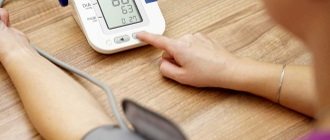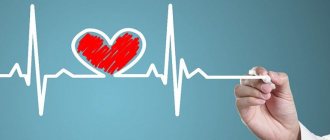- Two blood pressure readings
- What does the difference between upper and lower pressure mean?
- Reduced diastolic pressure
- High bottom pressure
- Increased systolic pressure
- Reduced upper pressure
- Controlling blood pressure is the key to the health of the whole body
Regularly measuring blood pressure is an important condition for maintaining health. A person may not feel a slight increase or decrease in blood pressure, but such changes indicate negative processes occurring in the body. If measures are not taken in time, there may be a negative effect on the heart and blood vessels, including a heart attack or stroke. This is why it is so important to use a home blood pressure monitor from time to time.
Why is the upper pressure increased and the lower pressure decreased?
Upper pressure reflects the condition of large blood vessels and cardiac activity. An increase in this indicator indicates heart disease, adrenal pathologies, and progressive arrhythmia.
Lower pressure - indicates the state of the tone of blood vessels, and its decrease in most cases is due to the development of atherosclerosis, insufficient elasticity of the vascular walls, and the formation of atherosclerotic plaques.
A large difference between systolic and diastolic indicators can be caused by the following factors:
- Hyperthyroidism;
- Recent stroke;
- Heart rhythm disturbances;
- Nephritis;
- Aortic atherosclerosis;
- The patient has a history of myocardial infarction;
- Nephrosis;
- Myocarditis;
- Heart failure.
The reasons for high upper pressure with low lower pressure can also be due to dysfunction of the thyroid gland, undesirable age-related changes, cardiac diseases, and vascular pathologies.
Systolic and diastolic pressure characterize different phases of the heart cycle
Reduced diastolic pressure
Low lower pressure is considered to be 50-59 units or less. Such changes indicate a violation of the tone of the vascular wall. When the indicator is less than 50 units, we can talk about a pronounced disturbance of blood flow in the brain, kidneys and other organs.
Diastolic pressure decreases against the background of kidney pathology, for example, Gitelman and Bartter syndromes. This phenomenon is also typical for people with a congenital disorder in the production of certain hormones, including adrenaline. Such changes are accompanied by fever, muscle weakness, vomiting, cramps and abdominal pain.
The first thing to do in such a situation is to consult a doctor. For diagnostic purposes, blood pressure monitoring and examinations are carried out to exclude endocrine pathologies and heart diseases. To increase lower blood pressure, special medications are used.
What is the danger of this condition?
High upper and low lower pressure is an alarming symptom that should never be ignored! Permanently increased pulse pressure indicates negative changes occurring in the body that can provoke the development of a stroke or myocardial infarction.
With a pulse difference that occurs against the background of normal upper and reduced lower pressure, we can talk about pathologies such as myocarditis, cardiodilation, decreased vascular elasticity, myopathy, which require timely medical intervention and competent therapy.
If the difference is associated with an increase in upper blood pressure, this can lead to a number of dangerous complications affecting the heart, kidneys, and blood vessels. In this condition, there is a high risk of developing cardiac diseases, atherosclerosis, and renal pathologies.
For this reason, if a person has a persistently low diastolic with an increased systolic, it is necessary to contact a qualified specialist as soon as possible, undergo a medical examination, find out the exact diagnosis and causes of the pathological condition, and then undergo appropriate treatment.
Otherwise, the consequences can be very dire, including disability, loss of ability to work, and even the death of the patient!
The danger of high blood pressure
What does it mean if there is a big difference between SBP and DBP?
Doctors who are actively involved in the issue of ISAH and what to do about it clearly understand that elevated systolic blood pressure (SBP) has a much greater impact on the development of heart attacks, ischemic heart disease or cerebral strokes than DBP.
- Thus, in the process of observing different groups of patients, it was noticed that increased SBP can increase the risk of developing coronary artery disease by 3.7 times, and increased DBP by 2.8 times.
- With increased SBP, the risk of cerebral stroke increases by 8.2 times, and with increased DBP - only 4.4 times.
- With SBP above 160 and low DBP (less than 90), the incidence of stroke is several times higher than with the same SBP value, but with DBP more than 90 mmHg. Art.
Thus, a direct dependence of the frequency of threatening conditions on the value of pulse pressure was discovered. As can be seen from the above figures, a high pulse difference indicates an increased risk of stroke.
Moreover, it was possible to establish that a high pulse difference has the greatest prognostic value in women with hypertension from 49 to 70 years old.
About the condition when the lower pressure is low and the upper pressure is high, it is known that this means, first of all, a high pulse difference.
A high pulse difference for certain groups of patients is an immutable risk factor for the development of cerebral or cardiac accidents. You can draw your own conclusion - if such an imbalance is detected, you need to be examined and get a doctor’s recommendations for further action.
Symptoms of pathology
Unfortunately, often hypertension, provoked by a large difference in upper and lower pressure, does not manifest itself with any specific signs. As the pathological process progresses, the patient develops the following characteristic symptoms:
- Impaired coordination of movements;
- Chronic fatigue syndrome;
- Problems with memory and the ability to perceive new information, concentration;
- Chills, tremors;
- Excessively intense sweating;
- Lethargy, apathy, loss of strength;
- Panic attacks;
- Sleep disorders;
- Psycho-emotional instability, anxiety, restlessness, irritability;
- Rapid pulse;
- Heart rhythm disturbance.
A similar clinical picture is characteristic of pathological pulse pressure. However, if the difference between upper and lower blood pressure is due to a specific disease, damage to a specific organ or system, additional, specific signs are observed.
For heart failure
If the upper blood pressure is high and the lower blood pressure is low, due to heart failure, the difference is manifested by the following symptoms:
- Pastosity;
- Painful sensations localized in the chest area;
- Headache, migraine attacks;
- Heart rhythm disturbances;
- Dyspnea;
- Rapid heart rate (tachycardia);
- Extrasystole.
Patients may complain of heart pain and chest tightness.
Pressing chest pain may be a symptom of a large difference between upper and lower pressure
For atherosclerosis
If the cause of the excessive difference in pulse pressure lies in atherosclerosis, the following clinical picture is observed:
- A burning sensation, heaviness, numbness localized in the lower extremities;
- Increased fatigue of the legs when walking, physical activity;
- Trembling in the body;
- Feverish state;
- Pain syndrome localized in a specific part of the body;
- Dyspepsia;
- Fainting and pre-fainting conditions;
- Excessive dryness of the skin.
Symptoms may differ slightly depending on the form of atherosclerosis, which can be either local or total.
For thyroid diseases
One of the most common factors for increased heart rate difference is excessive production of thyroid hormones. High systolic pressure with low diastolic pressure, provoked by pathologies of the thyroid gland, is manifested by the following symptoms:
- Rapid pulse;
- Permanent feeling of hunger;
- Painful sensations localized in the abdominal area;
- Nausea;
- Hyperhidrosis;
- Erectile dysfunction in representatives of the stronger sex;
- Insomnia;
- Increased goiter;
- Menstrual irregularities in female patients;
- Tremor;
- Difficulty swallowing;
- Unreasonable anxiety, nervousness, irritability;
- Visual impairment;
- Increase in weight category.
In patients with hormonal imbalances and thyroid pathologies, the palms often sweat, the voice becomes hoarse, and the gaze becomes unblinking.
Reduced blood pressure in old age
— Ivan Ilyich, it is common for us that older people usually suffer from increased blood pressure, but what if the opposite dynamics are observed, with a decrease in blood pressure and why is low blood pressure dangerous in the elderly?
- If a person is hypotensive throughout his life, then even in old age this should not cause concern and a therapeutic increase in blood pressure.
In old age, constant blood pressure monitoring is indicated.
Concerns in old age should be caused by pathological causes of decreased performance, most often these are:
- reducing blood pressure due to taking medications to treat other diseases;
- internal bleeding;
- VSD;
- Astheno-depressive syndrome;
- hormonal imbalance;
- oncology.
— What symptoms should cause concern?
— The first thing in the elderly is a decrease in blood pressure and an increase in heart rate at the same time. This is evidence that the heart cannot cope with the load. Here are a few more symptoms of low blood pressure that should cause concern:
- pain in the heart muscle and headaches;
- pale skin and increased sweating;
- sensation of a foreign body in the larynx;
- trembling and tingling in the limbs;
- photophobia;
- dizziness and fainting.
— What does low blood pressure lead to in old age?
— Without normal diagnosis and identification of the real cause of the pathology, older people may face death, especially if the pressure drops to 60 mm Hg.
Diagnostic methods
A large difference in systolic and diastolic blood pressure is a sure sign of pathologies of an endocrine or cardiovascular nature. If a patient has a stable increase in upper pressure and low lower pressure, he is prescribed the following types of studies:
- Electrocardiogram;
- General and detailed laboratory blood tests;
- Hormone test;
- Ultrasound examination of the heart;
- Tests to determine cholesterol and blood glucose levels;
- Pressure monitoring using the Holter method.
Based on the results of the general examination, the patient is sent for additional diagnostics to a cardiologist or a specialist - endocrinologist.
Holter monitoring monitors heart function throughout the day
Types of hypotension
Reduced diastolic blood pressure (hypotension) is divided into several types:
- Orthostatic hypotension. This diagnosis can be made to an elderly person, since this condition is provoked by age-related changes in the body. A decrease in diastolic pressure can be observed during sudden movements - lifting or bending, when blood quickly flows into the limbs. However, with an immediate decrease in pressure, the heart continues to work at the same rhythm, despite the presence of weakness, loss of balance, or even fainting.
- Vegetovascular hypotension. It is observed more often in adolescents, when the nervous and cardiovascular systems are not yet fully formed, and the brain receives incorrect commands. If a command was given to increase the pressure, it decreases.
- Postprandial hypotension. This type of hypotension is manifested by a decrease in blood pressure after eating. The heart does not accelerate as the blood moves downward, there is no vasoconstriction, and the patient feels a sharp rush to the legs.
If diastolic pressure is reduced, but a high pulse is recorded, this condition is considered potentially dangerous. It indicates that the heart pumps blood with effort, and its passage through the capillaries occurs with difficulty.
Treatment of pulse hypertension
If the upper pressure is high and the lower pressure is low, a person needs competent therapy. Moreover, treatment should be aimed at eliminating the underlying disease that provoked an excessive difference in indicators. If there is a sharp deterioration in the condition, it is important to provide the patient with emergency emergency care.
Emergency help at home
You can stop an attack that is manifested by a large difference between the upper and lower pressure using the following recommendations from specialists:
- Provide the patient with absolute rest, eliminating any physical activity;
- Give Aspirin to prevent the development of thrombosis;
- Lay on the bed, providing free access to fresh air;
- Give a sedative.
After providing first aid measures, you should definitely call a specialist. Further treatment depends on the reasons that provoked the increase in upper pressure against the background of decreased lower pressure, and it should only be prescribed by a doctor after preliminary diagnosis!
Therapy of provoking diseases
High heart pressure with low kidney pressure requires drug therapy developed by a qualified specialist. In most cases, the following drugs are used to treat the pathological condition:
- Calcium antagonists (Isradipine, Nefidipine);
- Diuretics (Furosemide, Triampur, Lasix);
- Beta blockers (Propranolol, Bisoprolol tablets) are prescribed for concomitant palpitations.
It is necessary to take medications strictly following the dosage, treatment regimen, and duration of the therapeutic course prescribed by the doctor.
However, if the pathological pulse pressure is caused by a severe form of atherosclerosis, heart defects, or undesirable age-related changes, treatment will be only symptomatic, aimed at temporarily improving the patient’s condition.
Treatment for high blood pressure is prescribed by a doctor: a therapist or a cardiologist.
Cardiovascular pathologies
In case of high pulse pressure caused by cardiac diseases, drugs are prescribed whose action is aimed at maintaining cardiac activity:
- Calcium inhibitors (Verapamil, Diltiazem);
- Preparations with a high content of magnesium and potassium in the composition (Asparkam, Panangin, Aspangin).
The dosage of medications and the duration of the course are determined by a specialist on an individual basis.
For severe heart valve defects, conservative treatment will not give the desired effect and the patient may be indicated for surgical intervention.
Hyperthyroidism
With high systolic pressure and low diastolic pressure, provoked by hyperthyroidism, treatment involves constant use of drugs - thyreostatics (Metizol, Tyrozol, Mercazolil). The medications stabilize the patient’s hormonal levels, as a result of which blood pressure normalizes.
In addition to drug treatment, diet therapy is recommended. Patients should exclude fatty foods, chocolate, coffee drinks, and salt from their diet. The basis of the menu should be vegetables and fruits, lean meats.
Causes
If the lower pressure is constantly outside the norm, it means that an insufficient amount of blood passes through the network of arteries at the moment the heart muscle relaxes. This condition is considered pathological and dangerous and requires drug therapy and regular monitoring. It threatens gradual depletion of the myocardium if low diastolic pressure is constantly recorded with normal systolic pressure.
If both indicators decrease simultaneously, medications are not always prescribed; an examination of the patient is necessary. First of all, the difference in pressure and a decrease in diastolic values is observed in older people. This occurs during natural aging of the body or means depletion of the heart and blood vessels, which already requires therapeutic measures.
The next factor that needs to be taken into account when looking for the cause of low diastolic pressure is whether the person has bad habits. In smokers, nicotine leads to disturbances in the permeability of vascular walls and has a negative effect on the functions of the cardiovascular system as a whole. Alcohol abuse as a result of hangover and intoxication increases the load on the kidneys.
The body tries to remove alcohol, using its own resources, and the pressure drops. In cases where systolic pressure is high (more than 140 mmHg) and diastolic pressure is low, isolated systolic hypertension is diagnosed. Most often, this happens due to improper drug therapy, and the difference in pressure occurs as a reaction of the body.
An insufficient amount of blood entering the heart at the time of diastole (relaxation) also develops for the following reasons:
- hormonal and endocrine disorders - with hypothyroidism (insufficient production of thyroid hormones) the lower pressure often drops, while the upper pressure remains within normal limits;
- the result of losing a large amount of blood;
- dehydration;
- neurocircular dystonia - this condition is often diagnosed in adolescents and women during pregnancy, it is also called vegetative-vascular dystonia (the nervous system at this time cannot cope with the stress, which causes disruptions in the functioning of the heart and blood vessels, changing blood pressure);
- anemia;
- toxic shock is a condition requiring immediate medical attention when diastolic pressure is very low, less than 40 mmHg.
When looking for reasons for the regular recording of low diastolic pressure, the doctor should pay attention to what indicators were observed in the patient throughout his life. If the upper and lower blood pressure readings have always been slightly below normal, for example, 100/60 or 110/70, this may not indicate pathology.
It is not recommended to look for the root of the problem on your own; it is better to visit an experienced doctor
Folk recipes
Folk remedies such as ginseng, hawthorn, strawberry, grapefruit, and mulberry provide a good effect with increased upper pressure against the background of decreased lower pressure. Infusions and decoctions based on them strengthen blood vessels, the heart muscle, stabilize blood pressure and reduce the pulse difference.
The most effective in this regard are considered to be tinctures of hawthorn and ginseng. However, they can only be used after consultation with a specialist! Despite their natural composition, folk remedies for blood pressure have a number of contraindications and side effects.
Hawthorn has the following beneficial properties:
- Improving blood circulation and microcirculation;
- Sedative effect;
- Vasodilator effect;
- Normalization of metabolic processes in the myocardium.
However, the drug is contraindicated during pregnancy, breastfeeding, gastritis, ulcerative lesions of the gastrointestinal tract, and in childhood.
Herbal tinctures, like medications, have their contraindications
Ginseng should not be used in case of hyperthermia or increased susceptibility to allergic reactions. The tincture is not prescribed to small, minor patients, women expecting the birth of a baby or breastfeeding.
Before using any means from the arsenal of traditional medicine, a mandatory medical consultation is required!
Treatment of low blood pressure
— Ivan Ilyich, how is low blood pressure therapy carried out?
— First, its reasons must be clarified. If this is a symptom of another pathological process, treat the original source. If hypotension appears as an independent disease due to physiological factors, appropriate drug therapy is prescribed.
— What medications should you take for low blood pressure?
— What the patient needs for low blood pressure should be decided by the doctor, since therapy is purely individual, but I will give a number of medications and herbal preparations to increase blood pressure.
Table No. 4. Drugs to increase blood pressure:
| Medications | Herbal preparations | ||
| Name | Description | Name | Description |
| Citramon | A drug based on caffeine, paracetamol and aspirin. The most affordable price for the drug from the entire list of medications | Pantocrine | The drug, based on deer antler, normalizes blood pressure and improves overall well-being. |
| Heptamil | The drug does not spike and gently increases blood pressure and has a beneficial effect on the cardiovascular system | Caffeine | Raises blood pressure, but is contraindicated for arrhythmia and heart failure. |
| Niketamide | A drug to increase blood pressure, the instructions prohibit taking it without consulting a doctor | Eleutherococcus extract | Drops for low blood pressure, normalize indicators and stabilize the functioning of the heart muscle |
| Fludocortisone | The drug is prescribed by a doctor for low blood pressure due to oxygen starvation, which is accompanied by fainting. | Ginseng tincture | Among the positive qualities of the drug is not only stabilization of blood pressure, but also tonic properties for the whole body (increases performance and gives vigor). |
Cordiamine can be taken from the first days of life.
I would also like to mention Cordiamine drops for low blood pressure. This is a good medicine for a sharp drop in blood pressure, regardless of the cause. The drug can also be used for collapse, heart failure, asphyxia, and circulatory disorders.
Treatment for low blood pressure with cordiamine is carried out according to the following instructions:
- adults from 25 years old from 15-40 drops up to three times a day;
- children take one drop per year of life, for example, for a 7-year-old, the single dose is seven drops;
- children from ten to sixteen years old take 10 drops at a time;
- from 16 years old according to the adult dosage;
- during pregnancy, in the second trimester and 3rd trimester, drops can be prescribed sporadically with a strong decrease in blood pressure (a single dose of 30 drops).
For non-critical pressure surges, you can use traditional medicine. What is recommended to take:
- Green tea with honey and lemon.
- Natural brewed coffee.
- Radiola rosea tincture.
- Herbal infusions from hawthorn.
- Immortelle decoction.
Natural brewed coffee increases low blood pressure.
— What should people with low blood pressure eat?
- First of all, meals should be regular and frequent at least five times a day, but in small portions. The diet should consist of:
- From dishes with the addition of a moderate amount of salt, as it tends to retain water in the body and, accordingly, increase blood pressure.
- Hot and spicy dishes stimulate the glands and tone the body.
- Fatty meats and fish are rich in cholesterol, which affects blood pressure.
- Smoked meats.
But when consuming such food, it is worth remembering that it is high in calories and can lead to weight gain and swelling. People with such problems should limit the amount of calories they consume. For all patients with pressure abnormalities, I recommend watching Elena Malysheva’s video, Live Healthy “Hypotension.”
Prevention measures
In order to avoid differences in pulse pressure, just listen to the following recommendations:
- Give the body regular, feasible physical activity;
- Avoid stressful situations;
- Refrain from smoking and drinking alcohol;
- Eat properly, balanced.
If systolic pressure is increased and diastolic pressure is decreased, it means that dangerous changes are occurring in the body. Therefore, a patient with a large pulse difference needs to undergo examination as soon as possible and begin treatment!
Questions from our readers
— Ivan Ilyich, our readers ask a lot of questions about hypotension, here are a few of them.
Heat and low blood pressure
— Why does the heat reduce blood pressure?
— Not only hypotensive people, nor hypertensive people, suffer from a decrease in blood pressure during the hot season; some benefit from it, while others cause problems with their well-being. The reason is the increase in temperature and subsequent increase in the concentration of carbon dioxide. The gas has the properties to influence blood vessels, dilating them, and as a result, reducing blood pressure.
Smoking and blood pressure surges
-I quit smoking, low blood pressure appeared, why?
— The reason is the effect of nicotine on the body, which has a constricting effect on blood vessels. With prolonged smoking, the functioning of the cardiovascular system is completely disrupted, which leads to pressure surges. Both its increase and decrease can be observed.
Drop in blood pressure after exercise
— Why is my blood pressure low after training?
— This is an abnormal reaction of the body from a physiological point of view and you should consult a doctor. The reason for this reaction of the body can be both physiological factors and dangerous pathologies:
- overwork;
- mitral valve prolapse;
- angina pectoris.
Low blood pressure with hypertension
— Why did a hypertensive patient’s blood pressure become low?
- In this case, you should consult a doctor. A sharp decrease in blood pressure against the background of prolonged hypertension may indicate serious pathologies of the body, including heart disease, bleeding, infections, and neurological disorders. It can also be caused by taking inappropriate medications.
How does a hot bath affect blood pressure?
— Does a hot bath increase or decrease blood pressure?
— The effect of water, no matter hot or cold, on the body has long been studied by science called balneotherapy. It is used for therapeutic effects on the body using water procedures. Water is considered hot if it is higher than the temperature of the human body 38°-39°C.
When using a bath at such temperatures, it makes sweating more difficult, increasing body temperature. The heart muscle begins to contract more often. And this leads to an increase in pressure on the walls of blood vessels, and accordingly to an increase in blood pressure.
Low Hell as a sign of pregnancy
- Low blood pressure before a missed period can be a sign of pregnancy?
- Yes, this may be the first sign. The first signs of pregnancy, which are noticeable even before the onset of menstruation, are fatigue, which will accompany her condition throughout the first trimester. It's all about the increased production of progesterone, which has already been mentioned. Namely, this hormone entails disruptions in blood pressure and disruptions in heart rhythm.
Lowest blood pressure in the body
— Lowest pressure in capillaries?
- This is one of the most interesting questions about the human body, like the question where is the low pressure when inhaling? So, the pressure in the capillaries is 20-30 mm Hg, and the lowest pressure during inspiration is in the pleural cavity, its value is negative or lower than atmospheric by 4-6 mm Hg. Art.










